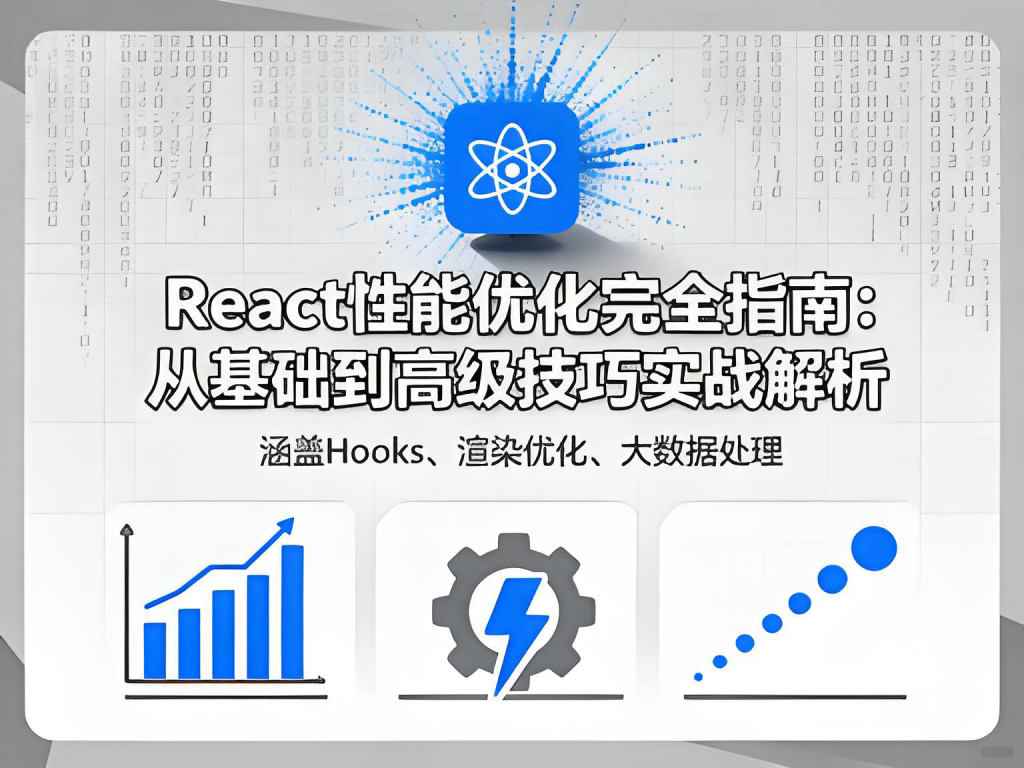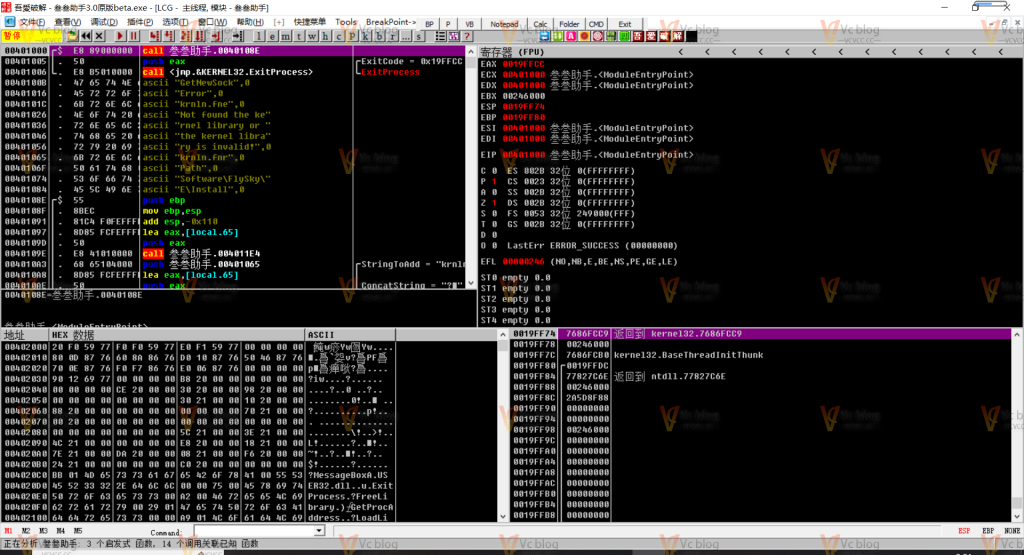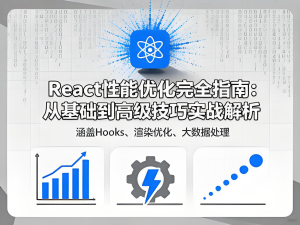React作为现代前端开发的主流框架,性能优化是每个开发者必须掌握的技能。本文系统梳理React性能优化的完整知识体系,从基础渲染原理到高级优化技巧,提供可运行的代码示例和详细的性能分析,帮助开发者构建高性能React应用。
![图片[1]-React性能优化完全指南:从基础到高级技巧实战解析](https://blogimg.vcvcc.cc/2025/11/20251113122246293-1024x768.png?imageView2/0/format/webp/q/75)
一、React渲染机制深度解析
1. Virtual DOM与Diff算法原理
import React, { useState, useEffect } from 'react';
// 模拟Virtual DOM更新过程
class VirtualDOMDemo extends React.Component {
state = { count: 0 };
// 模拟shouldComponentUpdate
shouldComponentUpdate(nextProps, nextState) {
console.log('当前状态:', this.state.count, '新状态:', nextState.count);
return this.state.count !== nextState.count;
}
handleClick = () => {
this.setState({ count: this.state.count + 1 });
console.log('状态更新触发重渲染');
};
render() {
return (
<div style={{ padding: '20px', border: '1px solid #ccc' }}>
<h3>Virtual DOM 演示</h3>
<p>计数: {this.state.count}</p>
<button onClick={this.handleClick}>增加计数</button>
<ChildComponent count={this.state.count} />
</div>
);
}
}
// 子组件 - 演示props变化时的渲染
class ChildComponent extends React.Component {
renderCount = 0;
render() {
this.renderCount++;
console.log(`子组件渲染次数: ${this.renderCount}`);
return (
<div style={{ marginTop: '10px', padding: '10px', background: '#f5f5f5' }}>
<p>子组件 - 接收的计数: {this.props.count}</p>
<p>子组件渲染次数: {this.renderCount}</p>
</div>
);
}
}
export default VirtualDOMDemo;2. React Fiber架构与并发特性
import React, { useState, useTransition } from 'react';
// 使用并发特性优化大型列表渲染
function ConcurrentFeatureDemo() {
const [tab, setTab] = useState('home');
const [isPending, startTransition] = useTransition();
const [list, setList] = useState([]);
// 模拟大数据量操作
const generateLargeList = () => {
const largeList = [];
for (let i = 0; i < 5000; i++) {
largeList.push(`项目 ${i + 1}`);
}
return largeList;
};
const handleTabChange = (newTab) => {
if (newTab === 'large') {
// 使用startTransition标记非紧急更新
startTransition(() => {
console.log('开始生成大型列表...');
setList(generateLargeList());
setTab(newTab);
});
} else {
setTab(newTab);
}
};
return (
<div style={{ padding: '20px' }}>
<h3>React并发特性演示</h3>
<div style={{ marginBottom: '20px' }}>
<button
onClick={() => handleTabChange('home')}
style={{ marginRight: '10px' }}
>
首页
</button>
<button
onClick={() => handleTabChange('about')}
style={{ marginRight: '10px' }}
>
关于
</button>
<button
onClick={() => handleTabChange('large')}
disabled={isPending}
>
{isPending ? '加载中...' : '大型列表'}
</button>
</div>
{isPending && <div>正在加载大型列表...</div>}
<div>
{tab === 'home' && <HomeTab />}
{tab === 'about' && <AboutTab />}
{tab === 'large' && <LargeList list={list} />}
</div>
</div>
);
}
function HomeTab() {
return <div>首页内容 - 轻量级组件</div>;
}
function AboutTab() {
return <div>关于页面 - 另一个轻量级组件</div>;
}
function LargeList({ list }) {
return (
<div style={{ maxHeight: '400px', overflow: 'auto' }}>
<h4>大型列表 ({list.length} 个项目)</h4>
<ul>
{list.map((item, index) => (
<li key={index} style={{ padding: '5px 0' }}>
{item}
</li>
))}
</ul>
</div>
);
}
export default ConcurrentFeatureDemo;二、组件级性能优化技巧
1. React.memo与Props优化
import React, { useState, memo, useMemo, useCallback } from 'react';
// 基础组件 - 未优化版本
const ExpensiveComponent = ({ user, onClick }) => {
console.log('昂贵的子组件渲染');
// 模拟昂贵的计算
const expensiveCalculation = () => {
let result = 0;
for (let i = 0; i < 1000000; i++) {
result += i;
}
return result;
};
const calculatedValue = expensiveCalculation();
return (
<div style={{ padding: '15px', border: '2px solid blue', margin: '10px 0' }}>
<h4>昂贵的组件</h4>
<p>用户名: {user.name}</p>
<p>计算结果: {calculatedValue}</p>
<button onClick={onClick}>点击回调</button>
</div>
);
};
// 优化版本 - 使用React.memo
const OptimizedExpensiveComponent = memo(({ user, onClick }) => {
console.log('优化后的昂贵子组件渲染');
const expensiveCalculation = () => {
let result = 0;
for (let i = 0; i < 1000000; i++) {
result += i;
}
return result;
};
const calculatedValue = expensiveCalculation();
return (
<div style={{ padding: '15px', border: '2px solid green', margin: '10px 0' }}>
<h4>优化后的昂贵组件</h4>
<p>用户名: {user.name}</p>
<p>计算结果: {calculatedValue}</p>
<button onClick={onClick}>点击回调</button>
</div>
);
});
// Props比较函数
const arePropsEqual = (prevProps, nextProps) => {
return (
prevProps.user.id === nextProps.user.id &&
prevProps.user.name === nextProps.user.name &&
prevProps.onClick === nextProps.onClick
);
};
// 深度优化版本
const DeepOptimizedComponent = memo(OptimizedExpensiveComponent, arePropsEqual);
function MemoOptimizationDemo() {
const [count, setCount] = useState(0);
const [user, setUser] = useState({ id: 1, name: '张三' });
// 未优化的回调函数 - 每次渲染都会创建新函数
const handleClickBad = () => {
console.log('点击处理');
};
// 使用useCallback优化的回调函数
const handleClickGood = useCallback(() => {
console.log('优化的点击处理');
}, []);
// 使用useMemo优化对象
const optimizedUser = useMemo(() => ({ ...user }), [user.id, user.name]);
return (
<div style={{ padding: '20px' }}>
<h2>React.memo 优化演示</h2>
<div style={{ marginBottom: '20px' }}>
<p>父组件计数: {count}</p>
<button onClick={() => setCount(count + 1)}>
增加计数 (触发父组件重渲染)
</button>
<button
onClick={() => setUser({ ...user, name: `用户${Date.now()}` })}
style={{ marginLeft: '10px' }}
>
更新用户信息
</button>
</div>
<div style={{ display: 'grid', gridTemplateColumns: '1fr 1fr 1fr', gap: '20px' }}>
{/* 未优化组件 */}
<div>
<h4>未优化组件</h4>
<ExpensiveComponent user={user} onClick={handleClickBad} />
</div>
{/* 基础优化组件 */}
<div>
<h4>React.memo优化</h4>
<OptimizedExpensiveComponent user={user} onClick={handleClickGood} />
</div>
{/* 深度优化组件 */}
<div>
<h4>深度优化</h4>
<DeepOptimizedComponent user={optimizedUser} onClick={handleClickGood} />
</div>
</div>
</div>
);
}
export default MemoOptimizationDemo;2. useMemo与useCallback实战
import React, { useState, useMemo, useCallback, useEffect } from 'react';
// 数据筛选和排序的优化示例
function DataProcessingDemo() {
const [users, setUsers] = useState([]);
const [filter, setFilter] = useState('');
const [sortBy, setSortBy] = useState('name');
const [renderCount, setRenderCount] = useState(0);
// 模拟数据加载
useEffect(() => {
const mockUsers = [
{ id: 1, name: '张三', age: 25, department: '技术部' },
{ id: 2, name: '李四', age: 30, department: '市场部' },
{ id: 3, name: '王五', age: 28, department: '技术部' },
{ id: 4, name: '赵六', age: 35, department: '人事部' },
{ id: 5, name: '钱七', age: 22, department: '市场部' },
];
setUsers(mockUsers);
}, []);
// 未优化的处理函数 - 每次渲染都会重新计算
const processDataBad = () => {
console.log('未优化的数据处理执行');
let processed = users.filter(user =>
user.name.includes(filter) || user.department.includes(filter)
);
processed.sort((a, b) => {
if (sortBy === 'name') return a.name.localeCompare(b.name);
if (sortBy === 'age') return a.age - b.age;
if (sortBy === 'department') return a.department.localeCompare(b.department);
return 0;
});
return processed;
};
// 使用useMemo优化的数据处理
const processedUsers = useMemo(() => {
console.log('优化的数据处理执行');
let processed = users.filter(user =>
user.name.includes(filter) || user.department.includes(filter)
);
processed.sort((a, b) => {
if (sortBy === 'name') return a.name.localeCompare(b.name);
if (sortBy === 'age') return a.age - b.age;
if (sortBy === 'department') return a.department.localeCompare(b.department);
return 0;
});
return processed;
}, [users, filter, sortBy]);
// 使用useCallback优化的事件处理
const handleFilterChange = useCallback((event) => {
setFilter(event.target.value);
}, []);
const handleSortChange = useCallback((event) => {
setSortBy(event.target.value);
}, []);
// 渲染计数
useEffect(() => {
setRenderCount(prev => prev + 1);
});
return (
<div style={{ padding: '20px' }}>
<h2>useMemo 和 useCallback 优化演示</h2>
<p>组件渲染次数: {renderCount}</p>
<div style={{ marginBottom: '20px' }}>
<input
type="text"
placeholder="过滤用户名或部门..."
value={filter}
onChange={handleFilterChange}
style={{ marginRight: '10px', padding: '5px' }}
/>
<select value={sortBy} onChange={handleSortChange} style={{ padding: '5px' }}>
<option value="name">按姓名排序</option>
<option value="age">按年龄排序</option>
<option value="department">按部门排序</option>
</select>
</div>
<UserList users={processedUsers} />
</div>
);
}
// 优化的用户列表组件
const UserList = React.memo(({ users }) => {
console.log('UserList 渲染');
return (
<div>
<h3>用户列表 ({users.length} 人)</h3>
<ul style={{ listStyle: 'none', padding: 0 }}>
{users.map(user => (
<UserListItem key={user.id} user={user} />
))}
</ul>
</div>
);
});
// 优化的用户列表项组件
const UserListItem = React.memo(({ user }) => {
console.log(`UserListItem ${user.id} 渲染`);
return (
<li style={{
padding: '10px',
margin: '5px 0',
border: '1px solid #ddd',
borderRadius: '4px'
}}>
<strong>{user.name}</strong> - 年龄: {user.age} - 部门: {user.department}
</li>
);
});
export default DataProcessingDemo;三、状态管理优化策略
1. 状态拆分与局部状态
import React, { useState, useContext, useMemo } from 'react';
// 错误的状态管理 - 所有状态放在一起
function BadStateManagement() {
const [globalState, setGlobalState] = useState({
user: { name: '用户', age: 25 },
theme: 'light',
notifications: [],
sidebar: { collapsed: false },
pageData: { title: '页面标题', content: '内容' }
});
const updateUser = (userData) => {
setGlobalState(prev => ({
...prev,
user: { ...prev.user, ...userData }
}));
};
const toggleTheme = () => {
setGlobalState(prev => ({
...prev,
theme: prev.theme === 'light' ? 'dark' : 'light'
}));
};
console.log('BadStateManagement 整体渲染');
return (
<div style={{ padding: '20px', border: '2px solid red', margin: '10px 0' }}>
<h3>错误的状态管理</h3>
<UserProfile
user={globalState.user}
onUpdate={updateUser}
/>
<ThemeToggle
theme={globalState.theme}
onToggle={toggleTheme}
/>
</div>
);
}
// 正确的状态管理 - 状态拆分
function GoodStateManagement() {
const [user, setUser] = useState({ name: '用户', age: 25 });
const [theme, setTheme] = useState('light');
const updateUser = (userData) => {
setUser(prev => ({ ...prev, ...userData }));
};
const toggleTheme = () => {
setTheme(prev => prev === 'light' ? 'dark' : 'light');
};
console.log('GoodStateManagement 渲染');
return (
<div style={{ padding: '20px', border: '2px solid green', margin: '10px 0' }}>
<h3>正确的状态管理</h3>
<UserProfile user={user} onUpdate={updateUser} />
<ThemeToggle theme={theme} onToggle={toggleTheme} />
</div>
);
}
// 用户资料组件
const UserProfile = React.memo(({ user, onUpdate }) => {
console.log('UserProfile 渲染');
return (
<div style={{ padding: '10px', background: '#f0f0f0', margin: '10px 0' }}>
<h4>用户资料</h4>
<p>姓名: {user.name}</p>
<p>年龄: {user.age}</p>
<button onClick={() => onUpdate({ age: user.age + 1 })}>
增加年龄
</button>
</div>
);
});
// 主题切换组件
const ThemeToggle = React.memo(({ theme, onToggle }) => {
console.log('ThemeToggle 渲染');
return (
<div style={{ padding: '10px', background: '#f0f0f0', margin: '10px 0' }}>
<h4>主题切换</h4>
<p>当前主题: {theme}</p>
<button onClick={onToggle}>
切换主题
</button>
</div>
);
});
// 状态管理优化演示组件
function StateManagementDemo() {
return (
<div style={{ padding: '20px' }}>
<h2>状态管理优化策略</h2>
<BadStateManagement />
<GoodStateManagement />
</div>
);
}
export default StateManagementDemo;2. Context优化与选择器模式
import React, { createContext, useContext, useReducer, useMemo, useCallback } from 'react';
// 未优化的Context
const UnoptimizedContext = createContext();
function UnoptimizedContextProvider({ children }) {
const [state, setState] = useState({
user: { id: 1, name: '张三', preferences: { theme: 'light' } },
notifications: [],
settings: { language: 'zh-CN' }
});
const value = { state, setState };
return (
<UnoptimizedContext.Provider value={value}>
{children}
</UnoptimizedContext.Provider>
);
}
// 优化的Context - 拆分Context
const UserContext = createContext();
const SettingsContext = createContext();
const NotificationsContext = createContext();
function OptimizedContextProvider({ children }) {
const [user, setUser] = useState({ id: 1, name: '张三', preferences: { theme: 'light' } });
const [settings, setSettings] = useState({ language: 'zh-CN' });
const [notifications, setNotifications] = useState([]);
// 使用useMemo优化Context值
const userValue = useMemo(() => ({ user, setUser }), [user]);
const settingsValue = useMemo(() => ({ settings, setSettings }), [settings]);
const notificationsValue = useMemo(() => ({ notifications, setNotifications }), [notifications]);
return (
<UserContext.Provider value={userValue}>
<SettingsContext.Provider value={settingsValue}>
<NotificationsContext.Provider value={notificationsValue}>
{children}
</NotificationsContext.Provider>
</SettingsContext.Provider>
</UserContext.Provider>
);
}
// 选择器Hook - 避免不必要的重渲染
function useUserSelector(selector) {
const { user } = useContext(UserContext);
return useMemo(() => selector(user), [user, selector]);
}
function useSettingsSelector(selector) {
const { settings } = useContext(SettingsContext);
return useMemo(() => selector(settings), [settings, selector]);
}
// 使用选择器的组件
function UserProfileWithSelector() {
const userName = useUserSelector(user => user.name);
const userTheme = useUserSelector(user => user.preferences.theme);
const language = useSettingsSelector(settings => settings.language);
console.log('UserProfileWithSelector 渲染');
return (
<div style={{ padding: '15px', border: '1px solid blue', margin: '10px 0' }}>
<h4>使用选择器的用户资料</h4>
<p>姓名: {userName}</p>
<p>主题: {userTheme}</p>
<p>语言: {language}</p>
</div>
);
}
// 直接使用Context的组件
function UserProfileDirect() {
const { user } = useContext(UserContext);
const { settings } = useContext(SettingsContext);
console.log('UserProfileDirect 渲染');
return (
<div style={{ padding: '15px', border: '1px solid green', margin: '10px 0' }}>
<h4>直接使用Context的用户资料</h4>
<p>姓名: {user.name}</p>
<p>主题: {user.preferences.theme}</p>
<p>语言: {settings.language}</p>
</div>
);
}
// Context优化演示
function ContextOptimizationDemo() {
const [count, setCount] = useState(0);
return (
<OptimizedContextProvider>
<div style={{ padding: '20px' }}>
<h2>Context 优化策略</h2>
<div style={{ marginBottom: '20px' }}>
<p>父组件计数: {count}</p>
<button onClick={() => setCount(count + 1)}>
触发父组件重渲染
</button>
</div>
<UserProfileWithSelector />
<UserProfileDirect />
<ContextUpdateDemo />
</div>
</OptimizedContextProvider>
);
}
// 演示Context更新的组件
function ContextUpdateDemo() {
const { setUser } = useContext(UserContext);
const { setSettings } = useContext(SettingsContext);
const updateUserName = useCallback(() => {
setUser(prev => ({
...prev,
name: `用户${Date.now()}`
}));
}, [setUser]);
const updateLanguage = useCallback(() => {
setSettings(prev => ({
...prev,
language: prev.language === 'zh-CN' ? 'en-US' : 'zh-CN'
}));
}, [setSettings]);
return (
<div style={{ padding: '15px', border: '1px solid orange', margin: '10px 0' }}>
<h4>Context 更新操作</h4>
<button onClick={updateUserName} style={{ marginRight: '10px' }}>
更新用户名
</button>
<button onClick={updateLanguage}>
切换语言
</button>
</div>
);
}
export default ContextOptimizationDemo;四、代码分割与懒加载
1. React.lazy与Suspense
import React, { Suspense, useState, lazy } from 'react';
// 模拟重组件
const HeavyComponent = lazy(() => {
return new Promise(resolve => {
// 模拟网络延迟
setTimeout(() => {
resolve({
default: () => {
// 模拟重组件的昂贵渲染
const startTime = performance.now();
while (performance.now() - startTime < 100) {
// 阻塞100ms模拟昂贵计算
}
return (
<div style={{ padding: '20px', border: '2px solid purple' }}>
<h3>重量级组件</h3>
<p>这个组件加载和渲染都很昂贵</p>
<p>加载时间: {new Date().toLocaleTimeString()}</p>
</div>
);
}
});
}, 1000);
});
});
// 错误边界组件
class ErrorBoundary extends React.Component {
state = { hasError: false };
static getDerivedStateFromError(error) {
return { hasError: true };
}
componentDidCatch(error, errorInfo) {
console.error('组件加载错误:', error, errorInfo);
}
render() {
if (this.state.hasError) {
return (
<div style={{ padding: '20px', border: '2px solid red' }}>
<h3>组件加载失败</h3>
<button onClick={() => this.setState({ hasError: false })}>
重试
</button>
</div>
);
}
return this.props.children;
}
}
function LazyLoadingDemo() {
const [showHeavy, setShowHeavy] = useState(false);
const [loadAttempts, setLoadAttempts] = useState(0);
const handleToggle = () => {
setShowHeavy(prev => !prev);
if (!showHeavy) {
setLoadAttempts(prev => prev + 1);
}
};
return (
<div style={{ padding: '20px' }}>
<h2>代码分割与懒加载演示</h2>
<div style={{ marginBottom: '20px' }}>
<button onClick={handleToggle}>
{showHeavy ? '隐藏' : '显示'} 重量级组件
</button>
<p>加载尝试次数: {loadAttempts}</p>
</div>
<ErrorBoundary>
<Suspense fallback={
<div style={{
padding: '40px',
textAlign: 'center',
border: '2px dashed #ccc'
}}>
<h3>🚀 组件加载中...</h3>
<p>这需要一些时间,请耐心等待</p>
<div style={{
width: '100%',
height: '4px',
background: '#f0f0f0',
marginTop: '20px'
}}>
<div style={{
width: '70%',
height: '100%',
background: '#007acc',
animation: 'loading 1.5s infinite'
}}></div>
</div>
</div>
}>
{showHeavy && <HeavyComponent />}
</Suspense>
</ErrorBoundary>
<style>
{`
@keyframes loading {
0% { transform: translateX(-100%); }
100% { transform: translateX(250%); }
}
`}
</style>
</div>
);
}
export default LazyLoadingDemo;2. 动态导入与路由分割
import React, { Suspense } from 'react';
import { BrowserRouter as Router, Routes, Route, Link } from 'react-router-dom';
// 动态导入页面组件
const Home = React.lazy(() => import('./pages/Home'));
const About = React.lazy(() => import('./pages/About'));
const Products = React.lazy(() => import('./pages/Products'));
const Contact = React.lazy(() => import('./pages/Contact'));
// 加载中组件
const LoadingSpinner = () => (
<div style={{
display: 'flex',
justifyContent: 'center',
alignItems: 'center',
height: '200px'
}}>
<div style={{
width: '40px',
height: '40px',
border: '4px solid #f3f3f3',
borderTop: '4px solid #007acc',
borderRadius: '50%',
animation: 'spin 1s linear infinite'
}}></div>
</div>
);
// 模拟页面组件
const MockHome = () => (
<div style={{ padding: '20px' }}>
<h2>首页</h2>
<p>这是首页内容,按需加载</p>
</div>
);
const MockAbout = () => (
<div style={{ padding: '20px' }}>
<h2>关于我们</h2>
<p>关于页面内容</p>
</div>
);
const MockProducts = () => (
<div style={{ padding: '20px' }}>
<h2>产品列表</h2>
<p>产品页面包含大量组件</p>
</div>
);
const MockContact = () => (
<div style={{ padding: '20px' }}>
<h2>联系我们</h2>
<p>联系表单页面</p>
</div>
);
// 路由配置
const routeConfig = [
{ path: '/', component: MockHome, name: '首页' },
{ path: '/about', component: MockAbout, name: '关于' },
{ path: '/products', component: MockProducts, name: '产品' },
{ path: '/contact', component: MockContact, name: '联系' },
];
function RouteBasedCodeSplitting() {
return (
<Router>
<div style={{ minHeight: '100vh' }}>
{/* 导航 */}
<nav style={{
padding: '20px',
background: '#f5f5f5',
borderBottom: '1px solid #ddd'
}}>
<h1>代码分割路由演示</h1>
<div>
{routeConfig.map(route => (
<Link
key={route.path}
to={route.path}
style={{
marginRight: '15px',
padding: '8px 16px',
textDecoration: 'none',
color: '#007acc',
border: '1px solid #007acc',
borderRadius: '4px'
}}
>
{route.name}
</Link>
))}
</div>
</nav>
{/* 路由内容 */}
<main>
<Suspense fallback={<LoadingSpinner />}>
<Routes>
{routeConfig.map(route => (
<Route
key={route.path}
path={route.path}
element={<route.component />}
/>
))}
</Routes>
</Suspense>
</main>
</div>
<style>
{`
@keyframes spin {
0% { transform: rotate(0deg); }
100% { transform: rotate(360deg); }
}
`}
</style>
</Router>
);
}
export default RouteBasedCodeSplitting;五、高级优化技巧
1. 虚拟列表与窗口化
import React, { useState, useMemo, useCallback, useEffect } from 'react';
// 虚拟列表组件
function VirtualList({
items,
itemHeight = 50,
containerHeight = 400,
overscan = 5
}) {
const [scrollTop, setScrollTop] = useState(0);
// 计算可见区域
const visibleRange = useMemo(() => {
const startIndex = Math.floor(scrollTop / itemHeight);
const visibleItemCount = Math.ceil(containerHeight / itemHeight);
const endIndex = startIndex + visibleItemCount + overscan;
return {
start: Math.max(0, startIndex - overscan),
end: Math.min(items.length, endIndex)
};
}, [scrollTop, items.length, itemHeight, containerHeight, overscan]);
// 可见项
const visibleItems = useMemo(() => {
return items.slice(visibleRange.start, visibleRange.end);
}, [items, visibleRange.start, visibleRange.end]);
// 总高度
const totalHeight = items.length * itemHeight;
// 偏移量
const offsetY = visibleRange.start * itemHeight;
const handleScroll = useCallback((event) => {
setScrollTop(event.target.scrollTop);
}, []);
return (
<div
style={{
height: containerHeight,
overflow: 'auto',
border: '1px solid #ccc'
}}
onScroll={handleScroll}
>
<div style={{ height: totalHeight, position: 'relative' }}>
<div style={{ transform: `translateY(${offsetY}px)` }}>
{visibleItems.map((item, index) => (
<VirtualListItem
key={item.id}
item={item}
style={{ height: itemHeight }}
absoluteIndex={visibleRange.start + index}
/>
))}
</div>
</div>
</div>
);
}
// 虚拟列表项
const VirtualListItem = React.memo(({ item, style, absoluteIndex }) => {
// 模拟昂贵的渲染
const renderStart = performance.now();
while (performance.now() - renderStart < 2) {
// 阻塞2ms模拟复杂渲染
}
return (
<div style={{
...style,
display: 'flex',
alignItems: 'center',
padding: '0 15px',
borderBottom: '1px solid #eee',
background: absoluteIndex % 2 === 0 ? '#f9f9f9' : 'white'
}}>
<span style={{ fontWeight: 'bold', marginRight: '10px' }}>
{absoluteIndex + 1}.
</span>
<span>{item.name}</span>
<span style={{ marginLeft: 'auto', color: '#666' }}>
{item.email}
</span>
</div>
);
});
// 虚拟列表演示
function VirtualListDemo() {
const [itemCount, setItemCount] = useState(1000);
const [useVirtual, setUseVirtual] = useState(true);
// 生成测试数据
const items = useMemo(() => {
return Array.from({ length: itemCount }, (_, index) => ({
id: index,
name: `用户 ${index + 1}`,
email: `user${index + 1}@example.com`
}));
}, [itemCount]);
// 普通列表(对比用)
function NormalList({ items }) {
return (
<div style={{ height: 400, overflow: 'auto', border: '1px solid #ccc' }}>
{items.map((item, index) => (
<div
key={item.id}
style={{
height: 50,
display: 'flex',
alignItems: 'center',
padding: '0 15px',
borderBottom: '1px solid #eee',
background: index % 2 === 0 ? '#f9f9f9' : 'white'
}}
>
<span style={{ fontWeight: 'bold', marginRight: '10px' }}>
{index + 1}.
</span>
<span>{item.name}</span>
<span style={{ marginLeft: 'auto', color: '#666' }}>
{item.email}
</span>
</div>
))}
</div>
);
}
return (
<div style={{ padding: '20px' }}>
<h2>虚拟列表优化演示</h2>
<div style={{ marginBottom: '20px' }}>
<label>
项目数量:
<input
type="number"
value={itemCount}
onChange={(e) => setItemCount(parseInt(e.target.value) || 0)}
style={{ margin: '0 10px', padding: '5px' }}
/>
</label>
<label>
<input
type="checkbox"
checked={useVirtual}
onChange={(e) => setUseVirtual(e.target.checked)}
style={{ marginRight: '5px' }}
/>
使用虚拟列表
</label>
</div>
<div style={{ marginBottom: '10px' }}>
<p>
当前显示: {itemCount} 个项目 |
模式: {useVirtual ? '虚拟列表' : '普通列表'}
</p>
</div>
{useVirtual ? (
<VirtualList items={items} />
) : (
<NormalList items={items} />
)}
<div style={{ marginTop: '20px', padding: '10px', background: '#f5f5f5' }}>
<h4>性能说明:</h4>
<ul>
<li>虚拟列表只渲染可见区域的项目,大幅提升性能</li>
<li>普通列表会渲染所有项目,在数据量大时性能急剧下降</li>
<li>尝试调整项目数量观察两种模式的差异</li>
</ul>
</div>
</div>
);
}
export default VirtualListDemo;2. Web Worker与离屏计算
import React, { useState, useRef, useCallback, useEffect } from 'react';
// 创建Web Worker
const createWorker = (workerFunction) => {
const workerCode = `
self.onmessage = function(e) {
const result = (${workerFunction.toString()})(e.data);
self.postMessage(result);
};
`;
const blob = new Blob([workerCode], { type: 'application/javascript' });
return new Worker(URL.createObjectURL(blob));
};
// 昂贵的计算函数
const expensiveCalculation = (data) => {
const { numbers, operation } = data;
console.log('Web Worker: 开始计算', numbers.length, '个数字');
const startTime = performance.now();
let result;
switch (operation) {
case 'sum':
result = numbers.reduce((acc, num) => acc + num, 0);
break;
case 'average':
const sum = numbers.reduce((acc, num) => acc + num, 0);
result = sum / numbers.length;
break;
case 'max':
result = Math.max(...numbers);
break;
case 'min':
result = Math.min(...numbers);
break;
default:
result = 0;
}
// 模拟更复杂的计算
for (let i = 0; i < 1000000; i++) {
Math.sqrt(i) * Math.random();
}
const endTime = performance.now();
console.log(`Web Worker: 计算完成,耗时 ${(endTime - startTime).toFixed(2)}ms`);
return {
result,
calculationTime: endTime - startTime,
dataSize: numbers.length
};
};
function WebWorkerDemo() {
const [numbers, setNumbers] = useState([]);
const [operation, setOperation] = useState('sum');
const [result, setResult] = useState(null);
const [isCalculating, setIsCalculating] = useState(false);
const [calculationMethod, setCalculationMethod] = useState('worker');
const workerRef = useRef(null);
// 初始化Web Worker
useEffect(() => {
workerRef.current = createWorker(expensiveCalculation);
workerRef.current.onmessage = (e) => {
setResult(e.data);
setIsCalculating(false);
};
workerRef.current.onerror = (error) => {
console.error('Web Worker 错误:', error);
setIsCalculating(false);
};
return () => {
if (workerRef.current) {
workerRef.current.terminate();
}
};
}, []);
// 生成测试数据
const generateNumbers = useCallback((count) => {
const newNumbers = Array.from({ length: count }, () =>
Math.floor(Math.random() * 1000)
);
setNumbers(newNumbers);
setResult(null);
}, []);
// 使用Web Worker计算
const calculateWithWorker = useCallback(() => {
if (!workerRef.current) return;
setIsCalculating(true);
workerRef.current.postMessage({
numbers,
operation
});
}, [numbers, operation]);
// 在主线程计算(会阻塞UI)
const calculateInMainThread = useCallback(() => {
setIsCalculating(true);
// 使用setTimeout让UI有机会更新加载状态
setTimeout(() => {
const startTime = performance.now();
const calculationResult = expensiveCalculation({ numbers, operation });
const endTime = performance.now();
setResult({
...calculationResult,
uiBlockedTime: endTime - startTime
});
setIsCalculating(false);
}, 100);
}, [numbers, operation]);
const handleCalculate = useCallback(() => {
if (calculationMethod === 'worker') {
calculateWithWorker();
} else {
calculateInMainThread();
}
}, [calculationMethod, calculateWithWorker, calculateInMainThread]);
return (
<div style={{ padding: '20px' }}>
<h2>Web Worker 性能优化演示</h2>
<div style={{ marginBottom: '20px' }}>
<button
onClick={() => generateNumbers(1000000)}
style={{ marginRight: '10px' }}
>
生成100万数字
</button>
<button
onClick={() => generateNumbers(5000000)}
disabled={isCalculating}
>
生成500万数字
</button>
<div style={{ marginTop: '10px' }}>
<span>当前数据量: {numbers.length.toLocaleString()} 个数字</span>
</div>
</div>
<div style={{ marginBottom: '20px' }}>
<label>
计算操作:
<select
value={operation}
onChange={(e) => setOperation(e.target.value)}
style={{ marginLeft: '10px', padding: '5px' }}
>
<option value="sum">求和</option>
<option value="average">平均值</option>
<option value="max">最大值</option>
<option value="min">最小值</option>
</select>
</label>
<label style={{ marginLeft: '20px' }}>
计算方式:
<select
value={calculationMethod}
onChange={(e) => setCalculationMethod(e.target.value)}
style={{ marginLeft: '10px', padding: '5px' }}
>
<option value="worker">Web Worker</option>
<option value="main">主线程</option>
</select>
</label>
</div>
<div style={{ marginBottom: '20px' }}>
<button
onClick={handleCalculate}
disabled={isCalculating || numbers.length === 0}
style={{
padding: '10px 20px',
background: isCalculating ? '#ccc' : '#007acc',
color: 'white',
border: 'none',
borderRadius: '4px'
}}
>
{isCalculating ? '计算中...' : '开始计算'}
</button>
</div>
{isCalculating && (
<div style={{
padding: '10px',
background: '#fff3cd',
border: '1px solid #ffeaa7',
marginBottom: '20px'
}}>
{calculationMethod === 'worker'
? '🔧 在Web Worker中计算,UI保持响应...'
: '⚠️ 在主线程计算,UI可能会卡顿...'}
</div>
)}
{result && (
<div style={{
padding: '15px',
background: '#d1ecf1',
border: '1px solid #bee5eb',
borderRadius: '4px'
}}>
<h3>计算结果</h3>
<p>操作: {operation}</p>
<p>结果: {result.result}</p>
<p>计算耗时: {result.calculationTime.toFixed(2)}ms</p>
<p>数据量: {result.dataSize.toLocaleString()} 个数字</p>
{result.uiBlockedTime && (
<p style={{ color: '#dc3545' }}>
UI阻塞时间: {result.uiBlockedTime.toFixed(2)}ms
</p>
)}
</div>
)}
<div style={{ marginTop: '20px', padding: '15px', background: '#f8f9fa' }}>
<h4>性能对比说明:</h4>
<ul>
<li><strong>Web Worker</strong>: 在后台线程计算,不阻塞UI</li>
<li><strong>主线程</strong>: 直接在主线程计算,会阻塞UI交互</li>
<li>尝试在计算过程中点击按钮或输入文本,体验差异</li>
</ul>
</div>
</div>
);
}
export default WebWorkerDemo;六、性能监控与分析
1. React DevTools性能分析
import React, { useState, Profiler } from 'react';
// Profiler 回调函数
const onRenderCallback = (id, phase, actualDuration, baseDuration, startTime, commitTime) => {
console.log('Profiler 数据:', {
id,
phase,
actualDuration: `${actualDuration.toFixed(2)}ms`,
baseDuration: `${baseDuration.toFixed(2)}ms`,
startTime: `${startTime.toFixed(2)}ms`,
commitTime: `${commitTime.toFixed(2)}ms`
});
};
// 性能监控组件
function PerformanceMonitor() {
const [renderCount, setRenderCount] = useState(0);
const [isMonitoring, setIsMonitoring] = useState(false);
const performanceData = useRef([]);
const customOnRenderCallback = (id, phase, actualDuration, baseDuration, startTime, commitTime) => {
if (isMonitoring) {
performanceData.current.push({
id,
phase,
actualDuration,
baseDuration,
startTime,
commitTime,
timestamp: Date.now()
});
}
};
const startMonitoring = () => {
performanceData.current = [];
setIsMonitoring(true);
};
const stopMonitoring = () => {
setIsMonitoring(false);
// 分析性能数据
const data = performanceData.current;
if (data.length > 0) {
const totalDuration = data.reduce((sum, item) => sum + item.actualDuration, 0);
const avgDuration = totalDuration / data.length;
console.log('性能分析报告:', {
'总渲染次数': data.length,
'总耗时': `${totalDuration.toFixed(2)}ms`,
'平均耗时': `${avgDuration.toFixed(2)}ms`,
'最慢渲染': `${Math.max(...data.map(d => d.actualDuration)).toFixed(2)}ms`
});
}
};
return (
<div style={{ padding: '20px' }}>
<h2>React 性能监控</h2>
<div style={{ marginBottom: '20px' }}>
<button
onClick={startMonitoring}
disabled={isMonitoring}
style={{ marginRight: '10px' }}
>
开始监控
</button>
<button
onClick={stopMonitoring}
disabled={!isMonitoring}
style={{ marginRight: '10px' }}
>
停止监控
</button>
<button onClick={() => setRenderCount(prev => prev + 1)}>
触发重渲染 ({renderCount})
</button>
</div>
{isMonitoring && (
<div style={{
padding: '10px',
background: '#d4edda',
border: '1px solid #c3e6cb',
marginBottom: '20px'
}}>
🎯 性能监控中... 打开浏览器控制台查看详细数据
</div>
)}
<Profiler id="MonitoredComponent" onRender={customOnRenderCallback}>
<MonitoredComponent renderCount={renderCount} />
</Profiler>
</div>
);
}
// 被监控的组件
const MonitoredComponent = React.memo(({ renderCount }) => {
const [localState, setLocalState] = useState(0);
// 模拟一些计算
const calculatedValue = useMemo(() => {
let result = 0;
for (let i = 0; i < 100000; i++) {
result += Math.sqrt(i);
}
return result;
}, []);
return (
<div style={{ padding: '20px', border: '2px solid #007acc' }}>
<h3>被监控的组件</h3>
<p>父组件渲染次数: {renderCount}</p>
<p>本地状态: {localState}</p>
<p>计算值: {calculatedValue.toFixed(2)}</p>
<button onClick={() => setLocalState(prev => prev + 1)}>
更新本地状态
</button>
<ChildComponent />
</div>
);
});
const ChildComponent = React.memo(() => {
console.log('子组件渲染');
return (
<div style={{
padding: '10px',
marginTop: '10px',
background: '#f8f9fa',
border: '1px solid #dee2e6'
}}>
<p>子组件内容</p>
</div>
);
});
export default PerformanceMonitor;七、总结与最佳实践
通过系统性地应用这些React性能优化技术,开发者可以:
1. 组件级优化
- 合理使用React.memo避免不必要的重渲染
- 正确使用useMemo和useCallback缓存计算和函数
- 通过状态拆分减少渲染范围
2. 架构级优化
- 实现代码分割和懒加载减少初始包体积
- 使用虚拟列表处理大数据量渲染
- 通过Web Worker卸载昂贵计算
3. 工具链支持
- 利用React DevTools进行性能分析
- 使用Profiler API监控生产环境性能
- 建立性能监控和警报系统
4. 开发规范
- 建立组件性能审查流程
- 制定状态管理最佳实践
- 培训团队掌握性能优化技能
通过掌握这些优化技术,开发者可以构建出高性能、可维护的React应用程序,为用户提供流畅的使用体验。
© 版权声明
THE END














暂无评论内容